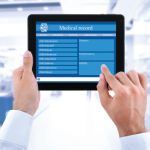Paper medical records traditionally were designed to reflect the clinical history and plan for the patient’s care. However, because billing requirements forced written documentation of all historical and observational elements personally done by the billing provider, detailed differential diagnoses and discussion largely disappeared from paper records, as did explanations for treatment recommendations and plans. When electronic records entered clinical workflow, they quickly became excellent tools for billing documentation. Indeed, billing documentation has now become one of the most important functions of the EHR, with many products striving to provide tools to enhance payment rates. This in turn has led to many automated features for clinical documentation whose sole purpose is to enhance billing efficiency. Many of these are automated features that are repetitive, redundant and irrelevant to the patient’s care, serving as barriers to clinical communication. Perhaps this was inevitable for an industry whose business model is based on transactions rather than outcomes.
The federal Meaningful Use and Value-Based Modifier Programs are initiatives to move transactional payment-to-value assessment for Medicaid and Medicare patients. However, the quality measures used in these programs remain crude and are not yet harmonized. Moreover, we remain focused on process improvements (such as DMARD prescription for RA patients), rather than quantitation of RA-associated disability and work loss. The certified EHR, accompanied by defined and standard terminologies, such as RxNorm, SNOMED and LOINC, is the key tool of these public (and many private) payer programs.
Drawbacks
We argue that the forced focus of EHR vendors and care providers in meeting these requirements has serious adverse effects, even though many requirements, such as exceptional EHR tools for patient engagement in care, are intrinsically valuable. For example:
- Today’s EHRs do not auto-adapt to the workflows of individual clinicians, and not surprisingly, EHR use is non-intuitive for many. That can mean increased work hours and/or decreased patient access, and paradoxically poor regulatory program “performance.” To wit, recent reports suggest that physicians are retiring earlier, and increasingly refusing to accept new Medicare patients in their practice.
- Focus on tracking discrete data elements has sacrificed the nuance and meaning that narrative may contain.
- “Copying forward” past observations into a current note has (somewhat) addressed billing requirements, but in so doing, increased the risk of medical error and in the plagiarism may in fact stretch common sense standards of ethical propriety and rigorous standards of compliance legality.
- “Copying in” large amounts of data into documentation risks both irrelevance and “note bloat,” diminishing its value to other providers and, therefore, the patient’s healthcare.
- The promise of clinical decision support in EHRs is often operationally diminished by the flood of alerts providers may experience, with the critical alert drowned out by the irrelevant.
Improvement Potential
The good news: EHRs could be built to address most of these concerns.
- There is great opportunity for enhanced focus on usability and, more specifically, decreasing clicks, integrating workflows and suggesting documentation tools based on past utilization. Depending on circumstance, and even by the same provider, some documentation is best done by flowsheet, others by form or template, still others as brief typed notes or dictation. Therefore, there is no ideal rheumatology documentation tool right for every rheumatologist (although we’ve seen some real progress).
- Highly accurate integrated voice recognition could be more widely disseminated (already here: “Cloud Dragon” requires no voice profile and is about 99% accurate).
- Advanced natural language processing has the opportunity to pull discrete information from narrative in real time.
- Vendors could incorporate metadata tagging of historical and observational data in terms of reliability, displaying a scale for presumed reliability of the observation. For example, reliability of observation of a small knee effusion in a crying, struggling, pudgy 2-year-old child.
- We could develop tools for graphical and/or tabular display of any data element by patient and provider population, real time, at provider request.
- There should be no need for the note creator to order data elements in SOAP, APSO or any other format—because the EHR should present information from the note according to the desires of the reviewer, while of course keeping the original signed version. For example, the consulting nephrologist, neurologist and cardiologist will each look for different emphasis and detail in the comprehensive rheumatology note of an admitted lupus patient with Type IV GN, seizures and pericardial effusion.
- User-defined alert levels and detail could minimize the alert bloat that is so common.
- With a focus on user needs, optional data presentation pertinent to the provider could be provided, tailored to the patient’s diagnosis. For example, a rheumatologist might order a CBC, CMP and UA as a safety check for an RA patient on methotrexate and naproxen, and these data might be presented showing Hgb, WBC, platelets, Cr, AST, ALT, LDH, urine protein and blood, plus additional results if abnormal.
- Clinical decision support for critical medical terms could be created, for example, advising the provider when diagnostic criteria are met (and not met). Today’s EHR uses standard terminology, but does not standardize its use. Although medical terminology a generation ago was largely private to the physician, today it’s the basis of procedure approval, billing, the onramp for the patient to learn more on the Internet, and also the primary communication tool between providers—some “a world away” in another emergency department.
- We can further refine superior search capabilities to focus on more relevant information elements.
There is no ideal rheumatology documentation tool right for every rheumatologist (although we’ve seen some real progress).
Added Features
The EHR has led to additional features and problems in comparison with paper clinical records. The first is the nonstandard clinical vocabulary, which characterized the paper electronic record. How many terms have been used to describe the concept of heart failure? The EHR has the capacity to constrain standards of vocabulary, whereas a blank page has an infinite capacity for diverse terms to describe clinical situations.

